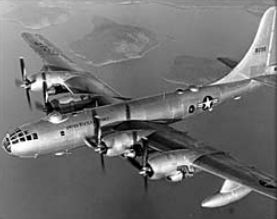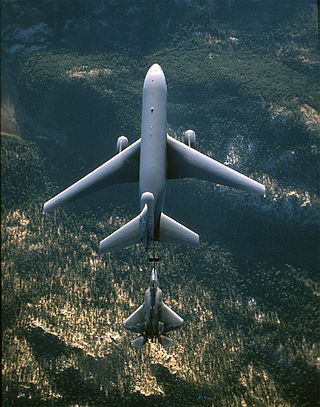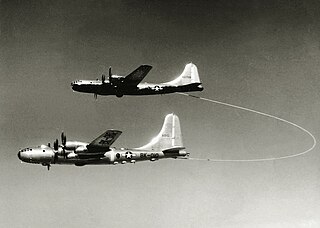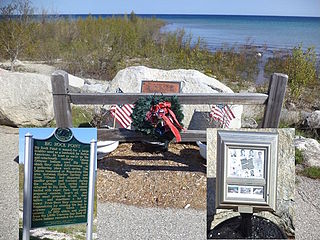
Aerial refueling (en-us), or aerial refuelling (en-gb), also referred to as air refueling, in-flight refueling (IFR), air-to-air refueling (AAR), and tanking, is the process of transferring aviation fuel from one aircraft to another while both aircraft are in flight. The two main refueling systems are probe-and-drogue, which is simpler to adapt to existing aircraft and the flying boom, which offers faster fuel transfer, but requires a dedicated boom operator station.

The Boeing B-50 Superfortress is an American strategic bomber. A post–World War II revision of the Boeing B-29 Superfortress, it was fitted with more powerful Pratt & Whitney R-4360 radial engines, stronger structure, a taller tail fin, and other improvements. It was the last piston-engined bomber built by Boeing for the United States Air Force, and was refined into Boeing's final such design, the prototype B-54. Although not as well known as its direct predecessor, the B-50 was in USAF service for nearly 20 years.

The 380th Air Expeditionary Wing is a provisional unit of the United States Air Force Air Combat Command (ACC). It is attached to the United States Air Forces Central Command component of ACC and is stationed at Al Dhafra Air Base, United Arab Emirates.

Straight Flush was the name of a B-29 Superfortress that participated in the atomic bomb attack on Hiroshima on August 6, 1945.

Full House was the name of a B-29 Superfortress participating in the atomic bomb attack on Hiroshima on August 6, 1945.

Necessary Evil, also referred to as Plane #91, was the name of Boeing B-29-45-MO Superfortress 44-86291, participating in the atomic bomb attack on Hiroshima on August 6, 1945.
Laggin' Dragon was the name of a Boeing B-29 Superfortress configured to carry the atomic bomb in World War II.

Big Stink – later renamed Dave's Dream – was a United States Army Air Forces Boeing B-29-40-MO Superfortress bomber that participated in the atomic bomb attack on Nagasaki, Japan on August 9, 1945. Assigned to the 393d Bomb Squadron, 509th Composite Group, it was used as a camera plane in support of the bomb-carrying B-29 Bockscar to photograph the explosion and effects of the bomb, and also to carry scientific observers. The mission was flown by crew C-14 but with Group Operations Officer Major James I. Hopkins, Jr., as the aircraft commander.

Question Mark ("?") was a modified Atlantic-Fokker C-2A transport airplane of the United States Army Air Corps. In 1929, commanded by Major Carl A. Spaatz, it was flown for a flight endurance record as part of an experiment with aerial refueling. Question Mark established new world records in aviation for sustained flight (heavier-than-air), refueled flight, sustained flight (lighter-than-air), and distance between January 1 and January 7, 1929, in a nonstop flight of 151 hours near Los Angeles, California.

The 6th Air Refueling Squadron is part of the 60th Air Mobility Wing at Travis Air Force Base, California. It operates the McDonnell Douglas KC-10 Extender aircraft conducting mobility, and air refueling missions.
To date, the United States Medal of Honor has been awarded on 103 occasions for actions involving the use of aircraft. Awards for actions that took place in a single flight are the norm, with 74 individual aircraft accounting for 82 of the 93 medals awarded for actions while in flight. Of those 75 planes, 41 were destroyed during the MoH action, while others were lost later. In a few cases the MoH recipient survived while the plane did not. The reverse also occurred: Lts. Jack W. Mathis and Robert E. Femoyer received posthumous awards while their respective Boeing B-17 Flying Fortresses survived, only to be scrapped later.

Lucky Lady II is a United States Air Force Boeing B-50 Superfortress that became the first airplane to circle the world nonstop. Its 1949 journey, assisted by in-flight refueling, lasted 94 hours and 1 minute.
This is a partial list of accidents and incidents involving the Boeing-designed B-17 Flying Fortress. Combat losses are not included except for a very few cases denoted by singular circumstances. A few documented drone attrition cases are also included.

Fortress is a 2012 American war film directed by Michael R. Phillips and stars Bug Hall, Donnie Jeffcoat, Sean McGowan and Joseph Williamson. The film was released by Bayou Pictures and although initially intended for wider release, was a direct-to-video release on July 31, 2012 made by Monarch Video. Fortress takes its name from the iconic Boeing B-17 Flying Fortress World War II bomber that was the centerpiece of the aerial battle in Europe.

The Wild Blue Yonder is a 1951 war film directed by Allan Dwan. The film stars Wendell Corey, Vera Ralston, Forrest Tucker and Phil Harris. Wild Blue Yonder deals with the Boeing B-29 Superfortress air raids on Japan during World War II.

On January 7, 1971, a Boeing B-52C Stratofortress of Strategic Air Command crashed into northern Lake Michigan at the mouth of Little Traverse Bay near Charlevoix, Michigan, while on a low-level training flight. All nine crew members aboard were lost. No remains of the crewmen were recovered. Parts of the aircraft were retrieved from a water depth of 225 feet (69 m) in May and June 1971. The structural remains included parts of the wings, all eight engines, the tail, crew section, landing gear and wheels, plus numerous smaller parts of the plane. Oceans Systems, a Florida-based salvage company, carried out the recovery mission.















